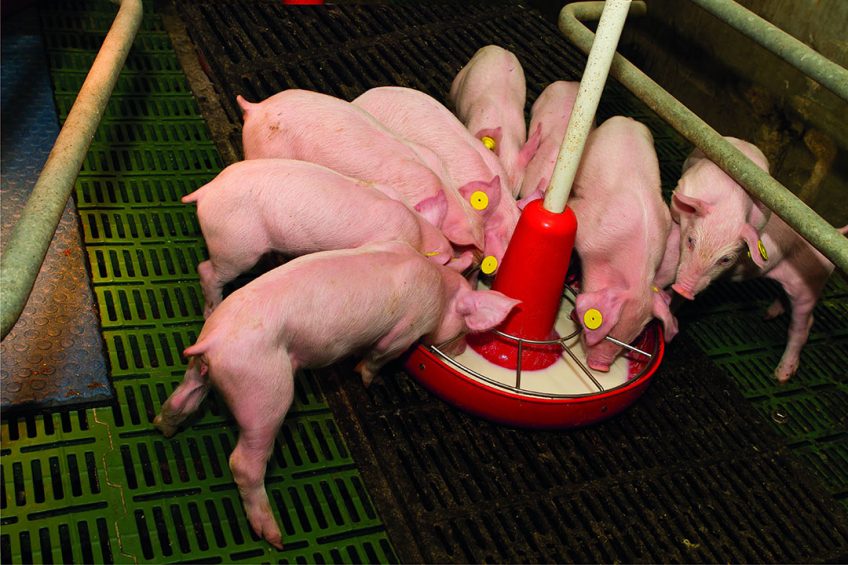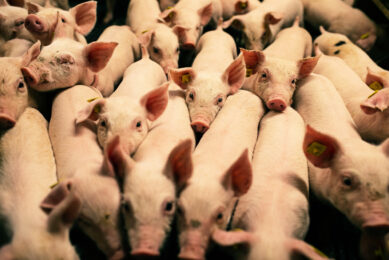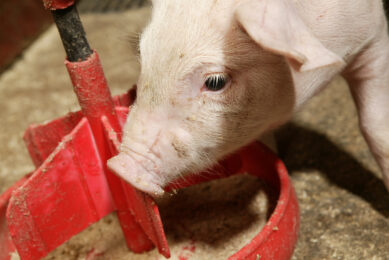No milk is the same – yet piglets like it all

There is only one letter difference between ‘sow’ and ‘cow’, yet they are completely different animals. Young piglets, however, these days get fed with milk from either porcine or bovine origin – they will thrive on both. How do sow milk and cow milk compare – and why does this work perfectly in practice?
Modern sows can do with a little assistance, when it comes down to lactation. After all, on average, sows produce 10-12 litres of milk per day. In most cases, that amount would be sufficient – but with highly prolific breeding lines that might have consequences. For sows, on one hand, as feeding large litters means they will have to use a lot of their body reserves to meet the high milk demand – which may in the end have a detrimental effect on performance in the next litter. For piglets on the other, as larger litters mean that they are generally born physiologically less developed. Plus: having a lot of siblings means a potential shortage of milk, so when the time comes for weaning, they are not up for it.
So, all in all, a little support would be welcomed and that is where milk products from dairy origin can play a role. Now how do sow and cow milk compare?
The phases of lactation
The exact compounds of what piglets will be drinking depend on many factors, which include e.g. genetics, parity, health and the sow’s nutrition. Most importantly, however, it is the lactation phase that determines the composition, as over the weeks during lactation, this tends to change, see also Table 1. Roughly, the lactation contents can be translated into 3 phases:
- Colostrum;
- Transition milk;
- Milk.
COLOSTRUM
Of these 3, colostrum is considered to be the most important for survival of the young piglet. Colostrum, available only straight after farrowing, provides piglets with energy, immunity and growth factors – it has everything newborn piglets need to get going. Conversely, insufficient colostrum intake is one of the most well-known causes for neonatal mortality.
Colostrum production with the sow is an autonomous process. Contrary to milk production, its production is usually not influenced by litter size or suckling stimulation. Colostrum availability can vary between 1-7 kg. In case of large litter sizes, there may not always be enough for every piglet.
Cow colostrum
In terms of contents, cow colostrum can be an alternative for sow colostrum. Just like porcine colostrum, the bovine variety is a great source of immunoglobulins. The major difference between the 2, however, is that porcine colostrum contains higher levels of dry matter and proteins. About 80% of all immunoglobulins in bovine colostrum are effective for piglets as well. Trials in 2002 already showed that immunoglobulin G (IgG) from bovine colostrum is being absorbed well by piglets. Among the major benefits of cow colostrum are:
- Lactoferrin is being absorbed in the piglets’ blood;
- Growth factors apply to piglets too (for about 80%);
- The vitamin and mineral content of porcine and bovine colostrum is identical.
SOW MILK
During the days post-farrowing, the milk’s fat content will gradually go up, where dry matter and protein content will come down. As from day 7 to 10, the milk’s composition will remain stable. Sow milk consists of protein, fats, carbohydrates, minerals and vitamins. A few of these ingredients deserve closer attention.
The most prominent source of carbohydrates in sow milk is lactose. In colostrum the percentage of lactose was still relatively low, but at this stage the percentage is higher. Between sows, the percentage of lactose does not vary as much.
Fats, on the other hand, are the largest and most fluctuating component in sow milk between sow’s. The amount depends e.g. on the sows nutrition.
Sow milk contains the same type of immunoglobulins as colostrum, just in lower percentages. Especially the amount of IgA will remain relatively high and will be created by the sow during her entire lactation phase – and distributed through the milk. This immunoglobulin will protect piglets from intestinal infections.
Cow milk
Table 2 also shows that sow milk, when compared to cow milk, has a higher dry matter content and a higher amount of fat content. When zooming in at milk on dry matter basis, it becomes apparent that cow milk has a higher protein percentage. Just like cow milk, sow milk has a casein component and a whey component. In cow milk, however, the amount of casein is higher when viewed on a dry matter basis.
In terms of fatty acid content, cow milk and sow milk are comparable. The same applies to lactose, the source of carbohydrates which can be absorbed quickly by young animals.
Milk replacers – how do they work?
So, both for colostrum as well as milk, dairy products can be a replacement. A dairy approach, however, also offers an advantage, which is related to the fact that the piglets’ digestive systems initially being oriented towards milk digestion. In those first weeks, all non-milk components will not be digested sufficiently, leading to diarrhoea. The transfer from milk towards vegetable-based solid feed – at weaning – is therefore a tremendous challenge, causing a changed intestinal microbiota, feed intake, and a pH value in the stomach.
This is where a dairy milk replacer can make a difference. The 3-step milk replacer series by Schils, the Netherlands, for instance, are spray-dried, homogeneously emulsified vegetable-based fats with a relatively high level of coconut oil and lactose. These dairy proteins provide a rapid recovery of the pH in the stomach, quicker than other proteins would do. Acids present include short chain fatty acids, which are often more easily digestible for young animals than long-chain fatty acids.
How do piglets perform on milk replacers?
In 2018, Schils had a trial set up at the Swine Innovation Centre (VIC), part of Wageningen University, the Netherlands. Litters of 40 gilts and sows joined in the trial – one half formed the control group, with the piglets receiving a regular pre-starter twice a day as from day 2 after farrowing. The other half received support of the Pigipro ALFF (Automatic Liquid Flexible Feeder), 24 times a day, a limited quantity every time. Weaning occurred at 28 days in both groups.
The trial yielded that at weaning, piglets in the group receiving support were heavier than the piglets in the control group. At 14 days of age, the piglets in the group receiving support were 530 g heavier than those in the control group – a weight difference that grew towards the end of the weaning phase. In comparison to the control group, 21% more piglets were weaned with a weight of more than 8 kg, and 3.6% fewer piglets were weaned with a weaning weight of lower than 6 kg. In addition, the research team found, the intake of the milk replacer did not reduce the intake of the weaner diet but rather increased the overall feed intake.
Authors: Nicole Lousberg, nutritionist, Schils Vincent ter Beek, editor, Pig Progress






